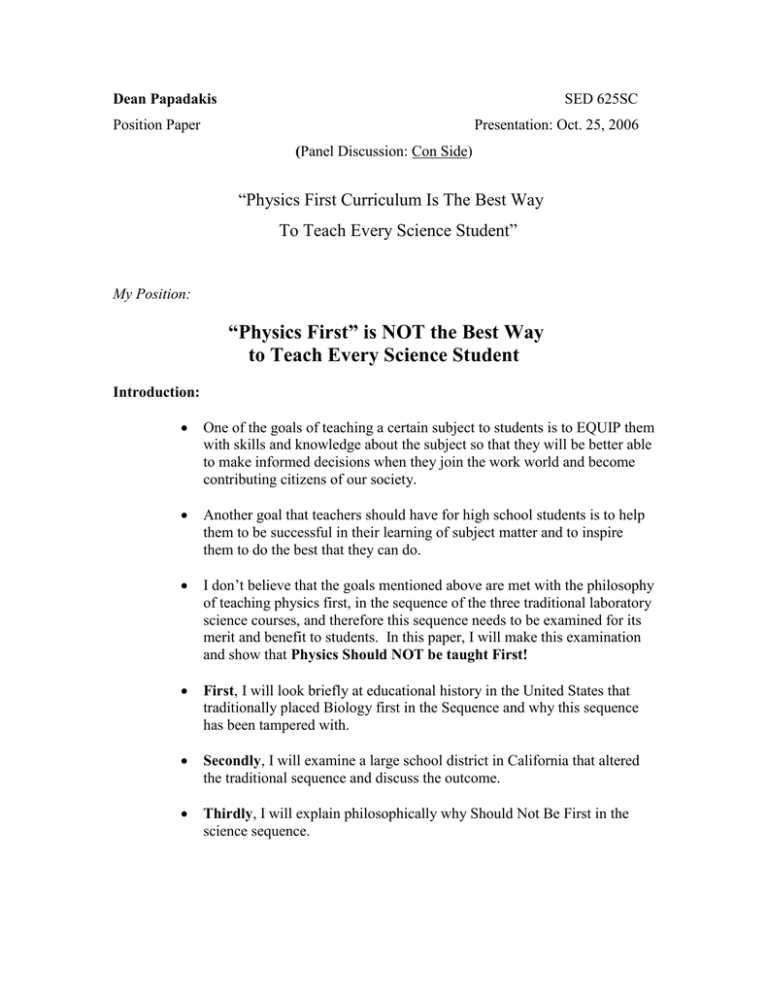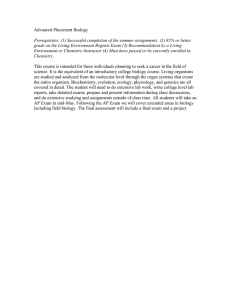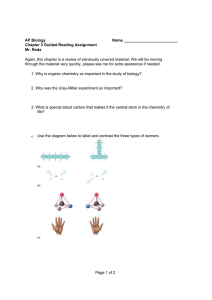Physics First Panel
advertisement

Dean Papadakis SED 625SC Position Paper Presentation: Oct. 25, 2006 (Panel Discussion: Con Side) “Physics First Curriculum Is The Best Way To Teach Every Science Student” My Position: “Physics First” is NOT the Best Way to Teach Every Science Student Introduction: One of the goals of teaching a certain subject to students is to EQUIP them with skills and knowledge about the subject so that they will be better able to make informed decisions when they join the work world and become contributing citizens of our society. Another goal that teachers should have for high school students is to help them to be successful in their learning of subject matter and to inspire them to do the best that they can do. I don’t believe that the goals mentioned above are met with the philosophy of teaching physics first, in the sequence of the three traditional laboratory science courses, and therefore this sequence needs to be examined for its merit and benefit to students. In this paper, I will make this examination and show that Physics Should NOT be taught First! First, I will look briefly at educational history in the United States that traditionally placed Biology first in the Sequence and why this sequence has been tampered with. Secondly, I will examine a large school district in California that altered the traditional sequence and discuss the outcome. Thirdly, I will explain philosophically why Should Not Be First in the science sequence. Body: The history of placing biology first, in the sequence of science courses, dates back over one hundred years to 1893 when a group of 10 educators known as the “Committee of Ten” recommended that biology be the main subject that was taught. The history of biology really dates back to Aristotle who spent time categorizing and describing living organisms. Chemistry is a relatively young science whose beginnings date back only about 200 years. So chemistry is really just as old as the birth of the United States of America. Their reasoning included the idea that biology then was a more descriptive course that did not need as much laboratory equipment and so was easier to teach. Today, biology is a much different subject that is not merely descriptive but takes a more molecular approach and uses much more biotechnology than ever before. This is one of the reasons that many educators believe that biology should be placed last in the sequence and have focused on placing physics first in the sequence. However, maybe another approach is to work on modifying how biology is taught as a first course, instead of switching it with physics. What are the TWO MAIN reasons that physics should not be taught before chemistry and biology. The first reason is that the “No Child Left Behind” policy mandates that all sophomore students be tested for life science with the California State Standards Test (CST), which does not require extensive math background. This is done whether or not they have taken biology or life science. So students who take physics first and biology last are doing poorly on a test that they are not prepared for and consequently, they bring the API score of a school down. The second reason, which is probably more compelling educationally, is that physics really does use the language of mathematics and formulas to communicate and demonstrate its principles and concepts. So if a student’s math skills are limited, this will make the learning of physics more difficult. Ninth graders really do not have enough mathematics skills to learn physics properly. A case in point is the San Diego Unified School System in Southern California. It is the second largest school district in California. In the year 2001, they mandated that all 9th grade students (10,000 students) would take physics first in the science sequence. This required a tremendous amount of money to hire 10 new teachers and to retrain 25 biology and chemistry teachers and to purchase new 9th grade level textbooks called “Active Physics”. This book was criticized because of its lower level of mathematics and “watered down” physics. They had to do this because they had to accommodate the lower level of math skills that freshmen have. In 2005, (four years after implementing physics first), only about 2% of Hispanic and African-American students scored at proficient or advanced levels on the CST physics test, which was an increase of 1% from 2003. Overall, 10% of San Diego students scored at proficient or advanced levels in physics, which was up only 4% from the 6% in 2003. These results have caused an outcry that has ultimately forced the district to eliminate the physics first and they plan to purchase new physics books (about $2 million) for the 2007-2008 school year and they are letting parents decide when their child takes physics. San Diego is the third largest biotechnology center in the United States. From the standpoint of jobs, it seems that San Diego students would have a better chance of employment in biotechnology after high school or college, if they were taking biology as freshmen and then maybe taking a more advanced molecular approach to biology, like A.P. biology as seniors. Finally, philosophically, advocates of physics first say that taking physics before chemistry is better because students will understand the concepts of atomic theory and molecules better if they study it in physics first. However, the topic of atomic theory and molecular theory is not a California State physics standard and so is not a required topic, so this negates the argument. Additionally, the physics CST exam is still geared towards 11th or 12th grade level, and so 9th grade students taking physics, would have a harder time with the CST exam. Since mathematics skills are more limited in freshmen and sophomores, taking biology first instead of physics first will increase their likelihood of success. One physics teacher from Connecticut, Fred Myers of Farmington High School, noted that his 9th grade physics students had great difficulty in understanding the concept of “acceleration”, even when it was taught within a conceptual framework. I wonder, if this can be partly attributed to the fact that 9th grade students still don’t drive a car. Therefore, would it not be easier for older students who can drive a car, to understand the concept of acceleration? Conclusion: Physics should not be the first course in the science sequence, taught to freshmen for the following reasons. The required math level for physics is not present in most 9th graders. The CST exam for life science will be given to them regardless of whether or not they have taken biology. What about the students who have limited English skills. They will have an easier time understanding physics with math, than just reading about it conceptually as 9th graders. Teaching biology first, does not imply necessarily that physics should be taught last. Maybe a valid compromise is to teach physics second between biology and chemistry. This helps to satisfy the limited math of freshmen and yet still helps to put physics before chemistry, so concepts of energy learned in physics can be applied to the motion of molecules in chemistry. In 1985, Nobel Laureate, Richard Feynman and David Goodstein, both of California Institute of Technology, debated along with Paul Hewitt (the author of Conceptual Physics) the issue of this paper, at La Canada High School. I was there and remember vividly the unwavering view of Feynman and Goodstein that physics should not be taught without sufficient math background. Another Nobel Laureate said the following: “I’m mostly interested in improving public science literacy. By the end of high school, a student should be ready for all possible futures, whether at work, in the military, in engineering school, college or family life. A good science and math education prepares students for life.” Do you think the Nobel Laureate who made this quote, is an advocate for “Physics First”?






